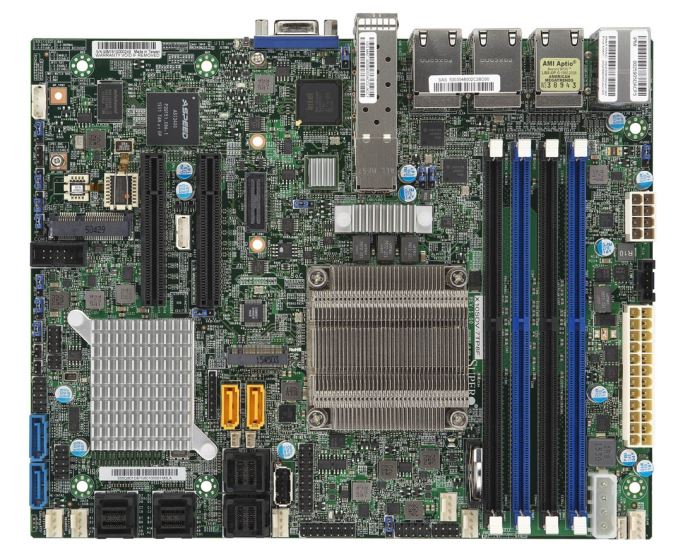Investigating Cavium's ThunderX: The First ARM Server SoC With Ambition
by Johan De Gelas on June 15, 2016 8:00 AM EST- Posted in
- SoCs
- IT Computing
- Enterprise
- Enterprise CPUs
- Microserver
- Cavium
The Top of the Line Xeon D: 16 Cores At 2.3 GHz
The Xeon D-1557 is a Xeon D with 12 cores running at 1.8 GHz most of the time (1.5 GHz base clock) that can boost to 2.1 GHz in single threaded circumstances. The reason for the modest clockspeed is simply the relatively low 45W TDP.
So if you need more CPU compute power, Intel has recently launched the Xeon D-1581, which contains 16 cores (32 threads) which can run at 2.3 GHz most of the time (1.8 GHz base), and boosts to 2.4 GHz. It does not seem to be available to everybody quite yet, but it is simply the slightly more powerful version of the earlier 1587, which runs one speed grade slower (1.7-2.3 GHz). Intel has not disclosed pricing yet, but it is not too hard to figure out. The Xeon D-1587 costs a daunting $1754, so it is very likely that the slightly faster Xeon D-1581 is around $1850.
To make the Xeon D-1581 equipped Supermicro X10SDV-7TP8F attractive, Supermicro turned it into a very luxurious board. They added the LSI 2116 RoC chip which adds up to 16 SATA3/SAS2 ports, and an Intel i350-AM4 (4 extra gigabit ports) and an Intel I210 (2 extra gigabit ports). So in total you can attach 4x SATA disks, 16x SAS disks, 6x GigE and 2x 10 GbE connections. Although we are impressed with the I/O capabilities, we feel that the Ethernet configuration is a bit too much of a good thing. If you configured something wrong, the fact that 3 different NIC chips are present makes debugging it harder. Nevertheless, it is an interesting alternative for a large part of the server market that does not need a 2 socket Xeon E5 but still needs a lot of local I/O.











82 Comments
View All Comments
JohanAnandtech - Wednesday, June 15, 2016 - link
Good suggestion. I have been using an ipmi client to manage several other servers, like the IBM servers. However, such a GUI client is still a bit more userfriendly, ipmi commands can get complicated if you don't use them regularly. The thing is that HP and Intel's BMC GUI are a lot easier to use and more reliable.fanofanand - Wednesday, June 15, 2016 - link
I think you may have an inaccurate figure of 141 at idle (in the graph) for the Thunder. "makes us suspect that the chip is consuming between 40 and 50W at idle, as measured at the wall"JohanAnandtech - Wednesday, June 15, 2016 - link
If you look at the Column "peak vs idle", you see 82W. At peak, we assume that a 120W TDP chip will probably need about 130W. 130W - 82W (both measured at the wall) = 50W for the SoC alone at idle measured at the wall, so anywhere between 40-50W in reality. My Calculation is a "guestimate", but it is clear that the Cavium chip needs much more in idle than the Intel chips.(10-15W) .djayjp - Wednesday, June 15, 2016 - link
Many spelling/grammar issues here. It impacts readability. Please read before posting.djayjp - Wednesday, June 15, 2016 - link
That is to say in the article.mariush - Wednesday, June 15, 2016 - link
These guys are already working on ThunderX2 (54 cores, 3 Ghz , 14nm , ARMv8) and they already have functional chips : https://www.youtube.com/watch?v=ei9uVskwPNEMeteor2 - Thursday, June 16, 2016 - link
It's always jam tomorrow, isn't it? Intel is working on new chips too, you know.beginner99 - Wednesday, June 15, 2016 - link
It loses very clearly in performance/watt to Xeon-D. In this segment the lower price doesn't matter in that case and the fact that it has a process disadvantage doesn't matter either. What counts is the end result. And I doubt it would cost $800 if made on 14/16nm. I mean why would anyone buying this take the risk? Safer bet to go with Intel also due to more flexible use (single and multi threaded). The latency issue is mentioned but downplayed.blaktron - Wednesday, June 15, 2016 - link
So downplayed. Anandtech desperately wants ARM servers, but its a solution looking for a problem. Big web front ends running on bare metal are such a small percentage of the server market that developing for it seems stupid. Xeon-D was already in development for SANs, they just repurposed it for docker and nginx.Senti - Wednesday, June 15, 2016 - link
Very nice article. I especially liked the emphasis on relations of test numbers and real world workloads and what was problematic during the testing.It would be great to see the same style desktop CPU review (Zen?) form you instead of mix of reprinted marketing hype with silly benchmark numbers dump that plagues this site for quite some time now.
Some annoying typos here and there, like "It is clear that the ThunderX is a match for high frequency trading", but nothing really bad.